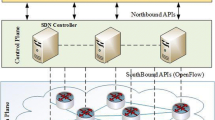Abstract
Future cellular networks will be of high capacity and heterogeneity. The structure and architecture will require high efficiency and scalability in network operation and management. In this paper, we address main requirements and challenges of future cellular networks and introduce network function virtualisation (NFV) with software defined networking (SDN) to realize the self-organizing (SO) scheme. NFV integrates the hardware appliances together in industry standard servers. And SDN performs as core controller of the network. The proposed SO scheme is based on soft fractional frequency reuse (SFFR) framework. The scheme takes different traffic demands into consideration and allocates the power adaptively. Finally the system is proved to be more scalable, energy-saving, and intelligent.



Similar content being viewed by others
References
Li Q, Hu RQ, Qian Y, Wu G (2012) Cooperative communications for wireless networks: techniques and applications in LTE-advanced systems. IEEE Wireless Commun 19(2):22–29
Peng M, Liang D, Wei Y, Li J, Chen H-H (2013) Self-configuration and self-optimization in LTE-advanced heterogeneous networks. IEEE Commun Mag 51(5):36–45
Kerpez KJ, Cioffi JM, Ginis G et al (2014) Software-defined access networks. IEEE Commun Mag 52(9):152–159
Lu K, Qian Y, Chen HH (2007) A secure and service-oriented network control framework for WiMAX networks. IEEE Comm 45(5):124–130
Lu K, Qian Y, Guizani M, Chen HH (2008) A framework for a distributed key management scheme in heterogeneous wireless sensor networks. IEEE Trans Wireless Commun 7(2):639–647
Hou I, Chen CS (2013) An energy-aware protocol for self-organizing heterogeneous LTE systems. IEEE J Select Areas Commun 31(5):937–946
Hu RQ, Qian Y (2013) Heterogeneous cellular networks. Wiley
Yan Y, Qian Y, Sharif H, Tipper D (2012) A survey on cyber security for smart grid communications. IEEE Commun Surveys Tutor 14(4):998–1010
IEEE C802.16m-08/782, Fractional frequency reuse in uplink, LG Electronics (2008) www.ieee802.org/16/tgm/contrib/C80216m-08782.doc
Donghee K, Ahn JY, Kim H (2011) Downlink transmit power allocation in soft fractional frequency reuse systems. ETRI J 33(1):1–5
Lu K, Qian Y, Chen HH, Fu S (2008) WiMAX networks: from access to service platform. IEEE Netw 22(3):38–45
Lim J, Hong D (2011) Management of neighbor cell lists and physical cell identifiers in self-organizing heterogeneous networks. IEEE J Commun Netw 13(4):367–376
Aliu OG, Imran A, Imran MA, Evans B (2013) A survey of self organisation in future cellular networks. IEEE Commun Surv Tutor 15(1):336–361
Fu S, Lu K, Qian Y, Varanasi M (2007) Cooperative network coding for wireless Ad-Hoc networks. In: Proceedings of IEEE Globecom2007. Washington
Bellavista P, Corradi A, Giannellin C (2008) Mobility-aware middleware for self-organizing heterogeneous networks with multihop multipath Connectivity. IEEE Wireless Commun Mag 15(6):22–30
Qi F, Sun S, Rong B, Hu RQ, Qian Y (2014) Cognitive radio based adaptive SON for LTE-A heterogeneous networks. In: IEEE global communications conference (GLOBECOM)
ETSI, Network functions virtualisation (NFV) ETSI industry group (2013) http://portal.etsi.org/portal/server.pt/community/NFV/367
Batalle J, Riera JF, Escalona E et al (2013) On the implementation of NFV over an OpenFlow infrastructure: routing function virtualization. In: 2013 IEEE SDN for future networks and services (SDN4FNS), pp 1–6
Kim H, Feamster N (2013) Improving network management with software defined networking. IEEE Commun Mag 51(2):114–119
Clayman S, Maini E, Galis A et al (2014) The dynamic placement of virtual network functions. In: 2014 IEEE network operations and management symposium (NOMS), pp 1–9
Pentikousis K, Wang Y, Hu W (2013) MobileFlow: toward software-defined mobile networks. IEEE Commun Mag 52(5):94–101
Acknowledgments
Project 61471066 supported by NSFC.
Author information
Authors and Affiliations
Corresponding author
Rights and permissions
About this article
Cite this article
Chen, N., Rong, B., Mouaki, A. et al. Self-Organizing Scheme Based on NFV and SDN Architecture for Future Heterogeneous Networks. Mobile Netw Appl 20, 466–472 (2015). https://doi.org/10.1007/s11036-015-0630-3
Published:
Issue Date:
DOI: https://doi.org/10.1007/s11036-015-0630-3




